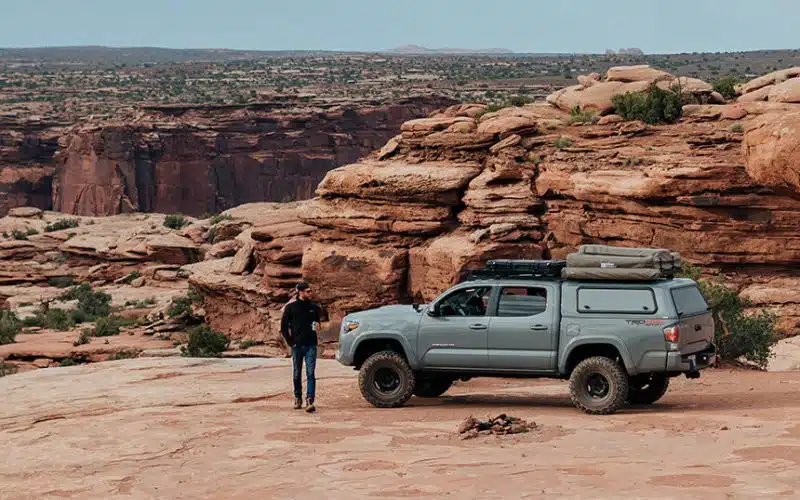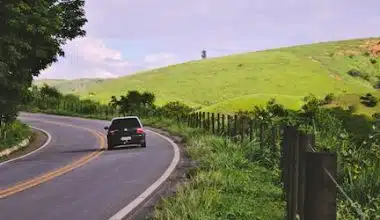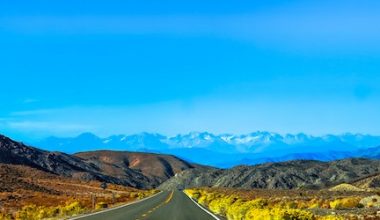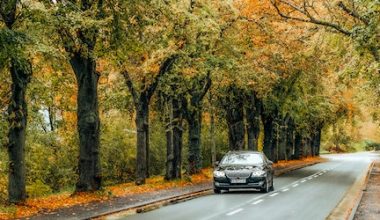Overlanding is, to put it simply, vehicle-based, off-road, and on-road adventure travel that emphasizes self-reliance, resilience, and enjoying the trip. Modern overlanding has captivated the interest of intrepid travelers all over the world since the invention of four-wheel-drive cars.
Overlanding is a global movement, but in the United States, it has become its own thing, with regional and national meetups and expos that offer instruction, vendors, and large outdoor spaces.
The passion for the great outdoors, camping, and discovering new locations is at the core of overlanding. Additionally, there is a fundamental fixation with vehicle maintenance, personalization, and designing a customized rig to fit the needs and character of each overlander.
The fact that anyone may undertake overlanding is its most alluring feature. Excellent resources are available to learn about car maintenance, navigation, off-roading, trip planning, communications, and other overland-related topics. You can begin modestly or venture far; frequently, it begins with a weekend here and there before becoming increasingly serious as your passion for Overlanding develops. It could permanently alter your life and become a habit.
What is Overlanding?
Remote travel, off-roading, and camping are all combined in overlanding. In Australia, long-distance travel routes were first established in the early 1900s, which is when overlanding first gained popularity. Mostly utilized for farm animal trade, people would walk livestock to markets along these trade routes. Later, under the influence of surveyor, road builder, and pioneer Leonard “Len” Beadell, overlanding changed and became an outdoor sport.
Long-distance travel to isolated areas with little prior exploration is typically involved in overlanding. Overlanding is also characterized by other qualities including survival, adventure, self-reliance, and discovery. Overlanding can include a wide range of activities, including scrambling over enormous boulders, wading through deep water, trudging through muck, and dashing over a dry lakebed.
Never deceive yourself. Even with its daring-sounding name, a weekend excursion spent stomping marshmallows over a calming campfire, scaling hurdles, and exploring trails does not qualify as overlanding. The real truth is getting off the grid and exploring the truly unknown for a period that might vary from days to weeks to months to years, depending on the voyage.
Overlanding is an enduring journey in pursuit of something bigger than yourself, not a holiday or an organized excursion at Zion National Park.
Overlanding Camper
The Overlanding sector has experienced growth over the last ten years. And with that, people have started outfitting vehicles and SUVs for camping in a variety of inventive ways. Some choose to camp in a rooftop tent, while others like the more subdued style of automobile camping or the outfitted overlanding trailer method. However, the overland camper option combines the greatest features of a rooftop tent with the luxury of a trailer.
Now, when you think of a truck bed dwelling, the first thing that probably comes to mind is a traditional bed camper, like the one you imagine sitting in your grandparents’ driveway. However, the choices available now are designed to be more agile on trails.
#1. GoFasterCampers Platform Camper
This is a really good camper overall. All of your belongings kept in the bed are safe behind locked doors, and there’s enough space for two people to sleep comfortably in the sleeping area. If you’re wondering how this is different from a bed rack with a rooftop tent, it’s because the floor of the tent can be removed to create a standing desk.
Remember that although the roof can support 500 pounds, it can only be opened when 75 pounds are placed within. That simply implies that when it comes to determining what needs to be removed from the roof when you get to camp, more preparation will be required.
#2. Napier Backroadz Truck Tent
You may find the thought of sleeping in your truck’s bed appealing, but the cost and space requirements of the other options may be too much for you to handle. This truck bed tent is an excellent option to hit the trail without having to sleep on the ground, even though it’s not quite a real camper shell. You’re set to go as long as you toss in your preferred air mattress.
#3. AT Overland Atlas
The pop-up tent adds 36 inches of additional headroom, which gives the camper a more roomy and comfortable feeling. Lead times vary, so make sure to plan for this one, but it might be well worth the wait.
The manufacturer offers a range of accessories, including fans, solar panels, and roof racks, to take advantage of the roof’s remarkable weight limit. You can also have several other opulent add-ons integrated into your camper. However, to obtain one, you will need to visit one of the dealers located around the nation.
#4. Scout Tuktut
While Scout Campers offers several extremely creative constructions, the Tuktut is the newest and lightest model in the series. Compared to other toppers on our list, the interior of the Tuktut will resemble a conventional truck bed camper the most. Mid-size vehicles were the target market for this design because of their ability to handle lighter, smaller structures. This is one of the most basic complete campers available, but there are plenty of options for modular modifications.
#5. Flatbed Air-Topper
When combined with the Flated Air Deck, you can have a lovely truck bed topper that also functions as a camper. When overlanding, this mattress/topper combination is very helpful since it allows you to stow your belongings underneath the mattress. Made from a cloth coated in PVC, the drop-stitch construction is incredibly rigid. It is quite similar to what you would experience on an inflatable paddle board.
It is simple to put up and take down because it is inflatable, though an electric pump would be useful. No tools are needed for the installation. The Flated Air-Topper can be used as a regular soft topper in addition to camping.
#6. SmartCap EVOa Adventure
Although it resembles a standard bed cap, it offers far more benefits for your overlanding equipment. MOLLE panels are included in this incredibly modular construction, but you can also add bins, drawers, camp kitchen setups, and a variety of other accessories. It requires some simple tools for initial installation, which takes approximately an hour, but when not in use, it can be taken apart in about 15 minutes.
You can choose to sleep here with the windows down, but as long as your truck can carry the weight, adding a rooftop tent should not be a problem because the roof is rated for a ton of weight.
#7. Four Wheel Campers Project M Topper
You’ll have no trouble finding a place to keep your overlanding equipment here. You can access your truck’s bed and all of your gear inside with complete access thanks to the back that flips open above the tailgate. If that isn’t enough room, you may add a roof rack on top. Your model can be ordered with gear tracks that let you put road recovery necessities.
One person can do it and it takes about a minute to open up. Additionally, depending on how deep your truck bed is, there are over six feet of standing room once the top is up. There are a few fans and lights on the roof that you can use with any of the various power sources the company offers. When it’s time to sleep, just fold out the mattress and slide the bed out.
#8. Lone Peak Camper
You may wonder how this is so cheap, and the answer is that, in comparison to truck bed campers, it’s rather basic. It is now simpler to adapt to your demands as a result. There won’t be any purchases made that you don’t need.
A fantastic rain guard for shedding water is included with the tent on Lone Peak. It keeps the weather inclement while allowing you to leave the windows open for fresh air. Huge windows that provide an amazing view of your campground are also present. Nothing compares to watching a stunning sunrise as soon as you get up.
#9. Alu-Cab Khaya Camper
This unit is heavier than the topper-style options on this list and packs a very substantial camper structure. Its sturdy design will endure for years, and since it slides on, you can always keep it packed and ready to use.
All of your equipment is safe because it already has lockable flip-up storage containers. You have up to eight feet of headroom when the tent is popped up, so even your tallest friends can use this one. There is a four-sleep arrangement for this camper as well. However, it does
#10. Off-Road RVs and 4×4 Camper Vans for Living That Luxe Van Life
With these cars, you may venture off the usual path and bring your house with you. Do you want to escape it all? Why not take an off-road RV, a vehicle that’s sturdy enough to handle the route but still manages to carry all the home comforts in one durable package, and drive away from civilization?
A subgroup of this special class of vehicles, off-road RVs and 4×4 camper vans combines the excitement of adventure with the assurance that, no matter how difficult the landscape outside gets, you won’t have to rough it. Which 4×4 vehicles and off-road RVs are worth giving another look at? The key to luxurious and stylish overlanding is these ten portable campers.
Overlanding Vehicle
Numerous vehicle types, such as SUVs, trucks, vans, and motorcycles, can be converted into capable overlanding rigs. Your overlanding fantasies can come true on any budget, whether it’s a high-mileage Jeep Cherokee you found on Craigslist, a minimally modified Ford Bronco, or an opulent Lexus LX 570. Some of the most well-liked models for adventures backed by vehicles include the Tacoma, 4Runner, and Toyota Land Cruiser. Not to mention the legendary Jeep Wrangler, Mercedes-Benz Sprinter, and Land Rover Defender.
An overlanding rig is merely a means to an end when traveling in an uncharted region; a well-prepared vehicle is still necessary. Stated differently, it serves as a tool to assist you in reaching your goal. A vehicle is an item of equipment you employ to get closer to the wilderness, just like the other stuff you carry. Equally crucial are plenty of water, food, tools, a first aid kit, utility jugs, a full-size spare, camping gear, and personal hygiene products.
Benefits of Overlanding
Overlanding has benefits, which include:
#1. You’ll Get the Break You Sorely Need.
To get away from the bustle and stress of the city, people take to inaccessible roads, scale mountains, and spend time in the great outdoors.
#2. You Get A Good Dose Of Sunshine
You receive enough vitamin D from the sun outside. Sunlight offers numerous advantages all by itself. Sunshine aids in the regulation of your natural cycle, or circadian rhythm, which allows your body to recognize when to release the hormone melatonin, which starts and sustains sleep.
Since too much sun might damage your skin, don’t forget to wear sunscreen.
#3. Incredible Advantages to Mental Health
Negative ions, which abound in forests, beaches, and waterfalls, are what you get when you immerse yourself in nature.
These ions elevate your mood and general well-being, balance your hormones, lessen stress and anxiety, and provide you with a sense of fulfillment.
Nature is visually stunning and breathtaking in and of itself. The advantages of taking in a sunset or the sound of falling streams can be explained without reference to science.
#4. Physical Health Benefits
Overlanding has health benefits for your body, just like any other physical activity does.
The amount of oxygen in your blood increases as you breathe in fresh air. Better lung function, a more active brain, healthier organs, and balanced hormones are all associated with a good oxygen supply.
Rough roads require you to be vigilant and engaged. Additionally, engaging in novel and mentally taxing activities, like exploring uncharted territory, enhances your cognitive abilities.
#5. It’s Liberating
Leaving your comfort zone makes you more independent, self-sufficient, and self-assured. You get a sense of freedom from it that comes from not spending forty hours a week at your desk.
If you’re lucky, your soothing stream or the lovely sounds of the birds singing will wake you up rather than your obnoxious alarm clock.
#6. You Become More Mindful Of Your Surroundings
Spending days in and around nature makes you more aware of it and more concerned about it.
You take on more responsibility for your actions. You’ll come to understand that nature can be a wonderful ally, giving you all you need, or, if you treat it badly, a terrible enemy.
#7. Your Character Develops
Regardless of how well you plan, things can still go wrong. On the other hand, handling unanticipated events might help you become resilient and patient.
Being separated from your small luxury helps you become more realistic.
What is an Overland Trip?
An overlanding journey is undertaken alone in a far-off or less-visited location. It usually calls for a vehicle (car, van, horse, 4×4, motorcycle, or bicycle) and emphasizes taking one’s time (from a few weeks to many years for some!).
What Is Overlanding vs. Camping?
Camping and off-road driving are combined in overlanding. Overlanding and camping are examples of sleeping in nature. What distinguishes overlanding from camping, then? Overlanding is more about the route there, whereas camping is more about sleeping at a location.
Why Is It Called Overlanding?
In the past, the word “overlanding” was used in Australia to describe the practice of herding cattle over extremely long distances in order to explore new territory or transport them to markets that are located far from grazing grounds. Alfred Canning established the Canning Stock Route in 1906–1910.
Who Goes Overlanding?
Although every group is different, it is likely that many participants from the UK, Australia, New Zealand, Canada, Scandinavia, Germany, the Netherlands, and the USA will be in their 20s and 30s, as well as a good number in their 40s, 50s, and 60s.
Summary
Overlanding success requires self-reliance, and mentality is crucial. You must be ready to switch to survival mode and take care of any maintenance requirements that come up while traveling. Harsh settings, severe temperatures, and potential wildlife encounters are additional considerations. Furthermore, keep in mind that independent travel also means going for days without taking a shower; eventually, all you’ll have to eat is an instant coffee pod and granola bar. You’re probably not overlanding if you’re too comfy, have cell service, a place to shower, and are located close to a petrol station or Taco Bell drive-thru.
- VAN RENTALS FOR ROAD TRIPS: Your Ultimate Guide to Exploring the Open Road
- BEST PLACES TO STAY IN CHICAGO IN 2024
- VAN RENTALS FOR ROAD TRIPS: Your Ultimate Guide to Exploring the Open Road
- BEST CAR FOR ROAD TRIPS: Top 10 Picks
- SAFEST CITIES IN SEATTLE IN 2023






